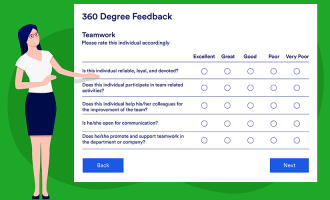Performance reviews are supposed to let employees know how they can improve their performance — but that isn’t always the case. According to a Gallup survey, only 14 percent of employees strongly agree that their performance reviews inspire them to improve their performance. This can leave managers frustrated because their employees aren’t getting better and employees discouraged because they can’t figure out what they need to do to improve.
Part of the problem is that performance reviews often sum up an employee’s work as a rating or ranking, without providing constructive feedback. The same Gallup survey found that only 29 percent of employees strongly agree that these reviews are fair, and only 26 percent strongly agree that they’re accurate.
If you want to use the performance review to actually improve performance, you’ll need to approach it in a different way. The mistake most companies make is looking at performance reviews as an annual benchmark. Instead, use these seven performance review tips to modernize the process and inspire employees to reach their goals.
1. Keep track of performance throughout the year
An annual performance review isn’t the only time to reflect on how well an employee is performing. Spend a few minutes every week noting where the employee is doing well and where they can improve, ideally by providing in-person feedback. Not only will this make annual reviews more accurately reflect how the employee is doing, but it will also provide you with opportunities to help your employees improve their performance throughout the year.
2. Collect feedback from multiple sources
While a direct manager’s feedback is valuable in gauging how an employee is performing, an employee’s peers may shed more light on their strengths and weaknesses. Provide a way for other managers who regularly interact with the employee, as well as members of their team and, if applicable, their direct reports, to evaluate them.
One of the ways to collect this feedback is to prepare separate forms to guide evaluations. For example, a feedback form from a peer could focus on teamwork and delegation, while a feedback form from a direct report would ask about how the employee is helping them meet their goals and objectives.
3. Encourage the employee to self-evaluate
As part of performance reviews, have the employee evaluate their own performance before you meet with them for their annual review. Providing a form can prepare them for what you’ll be evaluating and let you compare the results side by side. This encourages them to have a two-way conversation about their accomplishments and the obstacles keeping them from meeting goals.
Some of the things that should be included in the self-evaluation are what the employee is the proudest of, their own goals for their job performance, and how they believe their performance has affected the team and the company. This may provide insight into how you can support them in their efforts to improve.
4. Recognize the employee’s contributions
It’s all too easy to go into a performance review and note everything that the employee isn’t doing well. However, if you spend some time on what the employee has done well, they’ll have some positive takeaways and be able to build on those successes.
One example is a sales team member who has just barely made their quota. While this can and should be mentioned in the performance review, it’s also important to recognize that this employee has built a strong rapport with their customers and is considered approachable and helpful by the rest of the department.
5. Provide objective data
A performance review shouldn’t be entirely based on subjective opinions. To the extent that it’s possible, provide objective data and examples, particularly when highlighting areas for improvement. For a customer service representative, this could include how long it takes for them to resolve an issue on a call or how many times they escalated customer issues to another representative.
If you don’t have that kind of data, you can use specific examples, such as notes from previous one-on-one meetings. The feedback that you’ve collected from colleagues will also help here, particularly if they can provide an example of a time when the employee’s performance could have been better, like a reaction to a stressful situation.
6. Deliver actionable advice for improvement
When you’re giving a performance review, you want the employee to actually improve. This is why providing actionable advice is necessary. Give your employees specific things that they can do to boost their performance. This can be as formal as taking a course on using advanced features in the company’s bookkeeping software or as informal as asking for help when they need to prioritize multiple urgent tasks.
7. End on a positive note
It’s extremely unlikely that an employee will leave their performance review feeling like they can’t do anything right — and then magically improve. They’re more likely to polish their resume after an experience like that.
Instead, close the evaluation on a high note. Summarize the employee’s wins and go over the action plan the two of you are creating for improvement. For example, if the employee is struggling with meeting deadlines, help them create a plan so that they can work more efficiently or delegate some tasks.
Employees ideally should walk out of their performance reviews with a clear understanding of the company’s expectations for them and what they need to do to meet these expectations. Use these performance review tips to keep the encounter positive and foster a two-way conversation, and your employees will be inspired to improve.

















































































Send Comment: